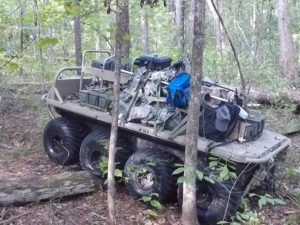NORFOLK, Va. — The Army is eyeing an open competition for the next version of its Small Multipurpose Equipment Transport (SMET) ground robots, with plans to pursue new multi-mission payloads for the platform.
Col. Shane Sullivan, project manager for force projection at the Army’s Program Executive Office Combat Support and Combat Service Support, said Wednesday officials are working through finalizing the requirements document for SMET Increment 2 over the next year and that it may include plans to procure 2,200 robot platforms.

“The Army’s looking at how good is [SMET] and what we can change for a larger procurement,” Sullivan said during a panel at NDIA’s Tactical Wheeled Vehicles Conference here. “For SMET Inc. 2, yes, the intent is to recompete the program. We’re waiting on that requirement to be developed.”
General Dynamics [GD] is currently manufacturing SMET for the Army after winning a $249 million production deal in July 2020 to deliver ground robots able to carry up payloads of up to 1,000 pounds, or about nine soldiers’ worth of equipment, as well traveling up to 60 miles over the course of 72 hours (Defense Daily, July 15, 2020).
Sullivan noted the Army is set to begin fielding the more than 600 SMET robots covered under the current deal within this year, while testing is ongoing with the 101st Airborne Division.
The next version of the platform is expected to grow the robots’ capacity with a range of new payloads, to include potential lethal effects, according to Sullivan.
“What we’re hearing is that as the requirements division at [Fort] Benning begins building this [SMET] Increment 2 requirement, it’ll come with some modular mission payloads that will go on top of that. I don’t know what those are going to be per se,” Sullivan said. “If you think about it, I’m sure you can come up with ideas yourself. You could put lethal things on top of there for the modular mission payload. You could put more batteries on top of there. You could put a retrans asset on there, a launch platform for quadcopters. The sky’s the limit.”
General Dynamics’ current contract was the Army’s second attempt at an award after the first deal was terminated following a successful protest from Textron [TXT], which claimed GD significantly altered its design following a soldier evaluation during the OTA period.
Following the protest decision, the Army restarted the competition in February and sent new Request for Proposals to the four original competitors: GD, Polaris [PII], HDT Expeditionary Systems and Textron’s Howe & Howe.
The Army ultimately received three bids for the final SMET contract, then awarding the deal to General Dynamics.